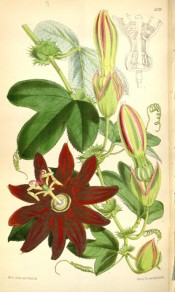Passiflora manicata (Juss.) Pers.
Frost-tender, robust climber with branching stems, 3-lobed leaves, to 10cm long, and saucer-shaped, bright red flowers, to 10cm across, with short, purple-blue and white coronas, followed by ovoid, glossy green fruit, to 5cm long. To 3m. [RHSE, Hortus].
Horticultural & Botanical History
‘This lovely plant has been for many years cultivated in England, though not so extensively as it deserves, having had the reputation of not flowering freely. It was introduced previous to 1850 by the Horticultural Society, through its collector Hartweg, who found it in hedges near Loxa in Peru, where, indeed, it was discovered by Humboldt and Bonpland half a century previously. It is also a native of the Andes of Equador and New Grenada, where it was found by Purdie on the arid plains of Suta Marchan, and is there called Ruruba de Seneno. A similar undescribed species, or perhaps a variety of this, with white flowers, was gathered by Pearce at Puquina (in Peru ?), at an elevation of 10,000 feet.’ [BM t.6129/1874]. FC p.74/1851. PFG pl.26/1853.
History at Camden Park
Listed only in the 1857 catalogue [T.972/1857].
Notes
Published Jan 31, 2010 - 02:47 PM | Last updated Jul 29, 2010 - 02:02 PM
| Family | Passifloraceae |
|---|---|
| Category | |
| Region of origin | South America |
| Synonyms |
|
| Common Name | Red passionflower |
| Name in the Camden Park Record |
Tacsonia manicata |
| Confidence level | high |


